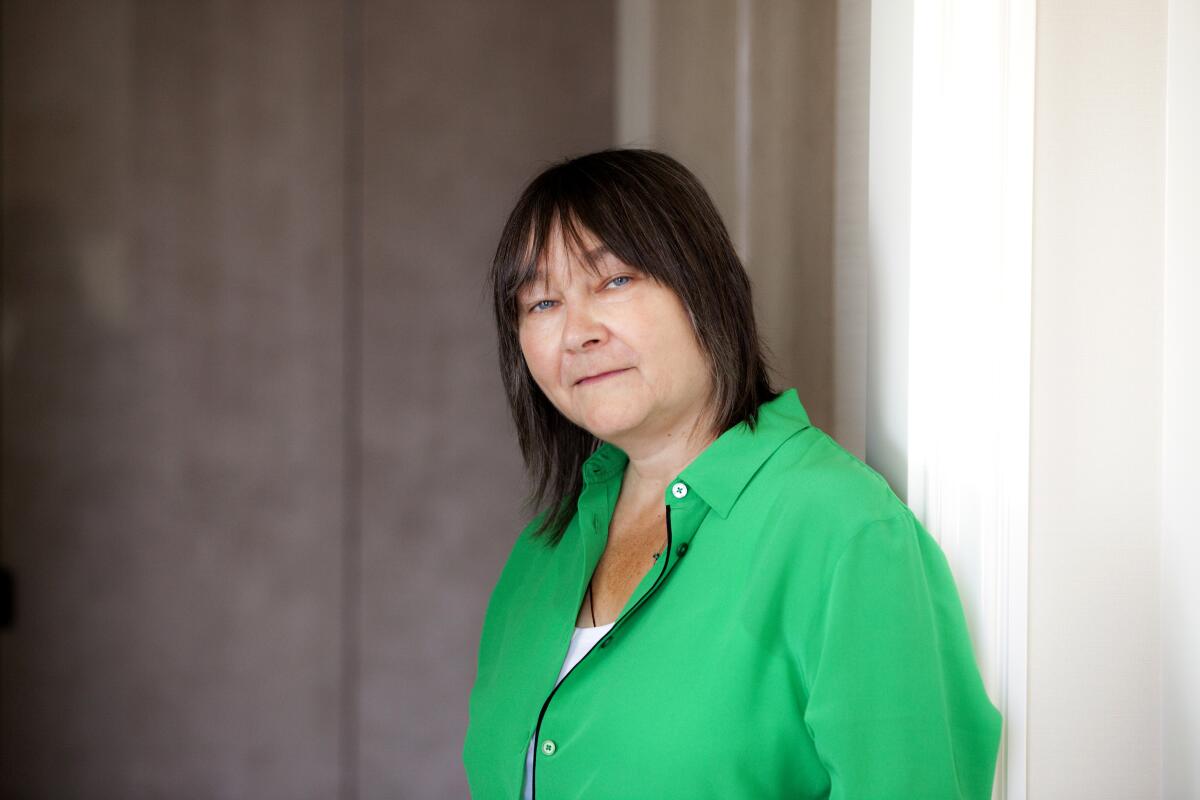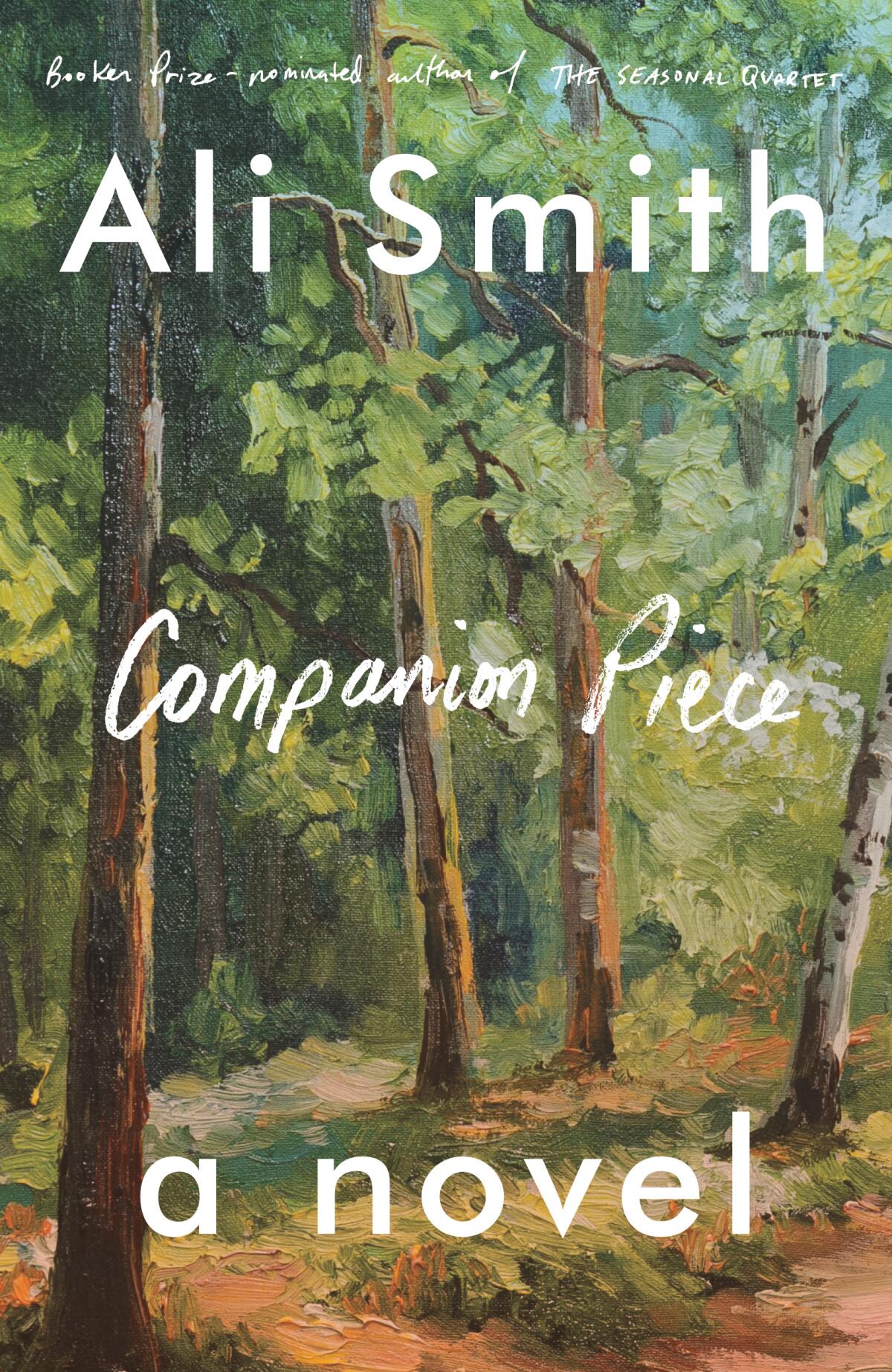Review: Why it’s great to be alive at the same time as author Ali Smith

- Share via
On the Shelf
'Companion Piece'
By Ali Smith
Pantheon: 240 pages, $28
If you buy books linked on our site, The Times may earn a commission from Bookshop.org, whose fees support independent bookstores.
It is remarkable to be alive at the same time as Scottish writer Ali Smith. No one else, I would argue, captures our ongoing contemporary nightmare in a manner that is both expansively imaginative and the perfect mirror of its abrupt absurdity. After five years of writing and publishing her seasonal quartet — an experiment in real-time fiction, both news-driven and profoundly thoughtful — Smith could be forgiven for taking a pause.
And yet, only two years after the quartet’s concluding volume, “Summer,” here is “Companion Piece,” a new novel equally focused on present-day anxieties. Smith recently told the BBC that while writing the series, “I knew there was a wild book at the back of it waiting, which was connected but not connected.”
Given Smith’s propensity for wordplay, it is safe to assume that “Companion’s” title is more than just a wink at the quartet. As much as it’s possible to read this stand-alone novel as the series’ coda, companion, like many of her touchstone words, carries multiple meanings.
Distilling the movement of Smith’s books into a neat summary is not only a challenge but somewhat beside the point. In her 12 novels, plot is often secondary to perspective and the cumulative impact of emotional, social and cultural entanglement. Nonetheless, I’ll try: Sandy Gray, a single queer painter in her mid-50s, usually lives alone in an inland region of the United Kingdom, though she is currently caring for her father’s dog while he is hospitalized with heart trouble. Each is all the other has of family in the world; Sandy’s mother left them when Sandy was a girl. Their devotion survives despite their differences, of which there are many.
Although her father sacrificed to send Sandy to university, he thinks little of her art: “all that learning, and all you’ve done with it is make a life’s work of for Christ sake painting words on top of one another so nobody can even read them.” Father and daughter do not share the same notion of success. “The life you could’ve had,” he says. “But no. Part time work. To fund your nonsense. Visual representations.” Her father’s condition is serious but not critical, though given his advanced age and the looming threat of COVID-19, this could change at any moment.

Masked and gloved herself as the medical staff is wearing “bin bags” for lack of proper PPE, Sandy visits her father, who lies “in a kind of hiatus between conscious and un, so tired he was still partly elsewhere.” Tasked by his nurse, Viola, to speak with him, Sandy pauses to think, “He was some place I couldn’t get into, its windows all dark to me. Or maybe it was me who was in the dark place and he was in a bright elsewhere.”
Sandy’s occupation is a familiar one for Smith. Her seasonal quartet shined a spotlight on several actual women artists, but in “Companion Piece,” it’s our central fictional heroine who creates. Sandy likes her chosen life, her “discipline,” as she tries to make her father understand. Her art grants her a purpose she doesn’t find in the companionship of others. Yet her father’s illness destabilizes that sense of self-sufficiency and separateness — particularly during a season of pandemic isolation.
It’s during this fragile moment that a tenuous connection resurfaces. Martina Gelf, a college classmate whom Sandy hadn’t spoken with since college, calls out of the blue. The two were never friends, having shared but one conversation about a poem by e.e. cummings. Remembering it, Martina reaches out to Sandy, calling on her nimble mind to unravel a mystery.
In ‘The Baby on the Fire Escape: Creativity, Motherhood, and the Mind-Baby Problem,’ Julie Phillips looks to 20th century artist-mothers for answers.
“She couldn’t have made up a story more likely to hook me,” thinks Sandy. Now an assistant to the curator at a national museum, Martina was detained at border control on her return from abroad because the passport she offered wasn’t the one she’d used on departing. “Is one country not enough for you?” an agent snapped. Then the agents checked her baggage and found the Boothby Lock, a cumbersome — and menacing — 16th century English lock and key. Assuming it was a weapon, they took Martina to an interview room, detaining her in isolation for seven and a half hours.
This all sounds more or less straightforward — until now. While left alone for hours, Martina began to hear a voice stating: “Curlew or curfew,” then, “You choose.” Now Martina and Sandy, reunited acquaintances, begin to parse the words’ meanings. Sandy considers the connection in a riff that’s Dan Brown by way of Judith Butler:
“[If] we think for a minute, I said, about the short span but the apparent freedom in the life of a bird, juxtaposed with the notion that what we do with our allotted time can be, or arguably always is, dictated or controlled one way or another not by nature alone but by outside forces like economics, history, social constraint, social convention, personal psychology and political and cultural zeitgeist. And if we think about the proffered choice, curlew or curfew, between nature and an authoritarian shaping of time, which is a human invention, or between the environment and our control of harmful and expedient use of the environment —” at which point Martina interrupts with laughter and says, “You haven’t changed a bit.”
Smith’s books often force one to think along such streams of consciousness before breaking the wave with a swell of emotion. Leaping from deep investigations of words and ideas to cultural references as lofty as Keats and as basic as Paul McCartney’s Wings (specifically, the song “Let ‘em In,” if you must know), Smith is intellectually rigorous yet democratic, warm and — crucially — playful.
The painter known to many as Lucian Freud’s one-time muse writes of her own muse, her mother, and provers herself a masterful writer as well.
What follows Sandy’s critical analysis is a family squabble involving Martina’s intense and hilarious twin young adult children; a history lesson in blacksmiths, the bubonic plague and the curlew bird; the story of a 14th century woman branded and expelled by her community; the acceptance of a lack of closure; and the discovery of the surprising resilience of tenuous bonds.
Throughout the novel, Smith returns to the power of stories and simple gestures that heal or unlock the damaged world we’ve inherited. She riffs, for instance, on the word “hello” — how it “holds its story ready, waiting. That’s pretty much all the story there is.” And, recognizing the capacity of any person or thing to become one’s companion, she draws from her well of wit and empathy to assemble a novel both enigmatic and inviting, begging to be read and reread.
With its sweeping and incisive vision, its proof that you can trap lightning in a bottle, “Companion Piece” shares the best qualities with the quartet to which it plays companion, offering a clever, erudite and humane portrait of our intense contemporary moment. Leaping from mythology to etymology, history to literature, she also makes the granular elements of daily movement the stuff of life-sustaining art. She shows, again, what exceptional fiction can do in troubled times that nothing else can.
LeBlanc is a book columnist for Observer. She lives in Chapel Hill, N.C.
More to Read
Sign up for our Book Club newsletter
Get the latest news, events and more from the Los Angeles Times Book Club, and help us get L.A. reading and talking.
You may occasionally receive promotional content from the Los Angeles Times.








